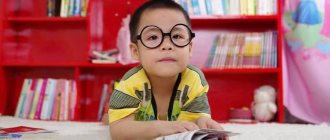Numerous errors in writing and reading can arise due to pedagogical neglect, inadequate teaching methods, and unsteady knowledge of the rules. But starting from the second grade, many children develop dyslexia (reading impairment) and dysgraphia (writing impairment). What are these disorders and how to teach children with such features?
The functional system of writing and reading is formed gradually; the mechanisms that ensure it mature as a whole by the beginning of schooling (by the age of 7).
Mastering literacy is a complex process that is influenced not only by internal factors that determine a child’s readiness to master skills, but also by external ones. In most cases, difficulties in mastering literacy are overcome in the learning process, as writing skills develop and strengthen, if the child has the necessary support from the teacher and parents.
To avoid pedagogical mistakes and eliminate negative pedagogical factors, teachers need to focus on understanding the capabilities and individual characteristics of the child, which allows them to build an optimal learning route.
However, in 12 - 37% (according to various sources) of children after seven years of age, disorders are identified, which are defined as dyslexia (reading impairment) and dysgraphia (writing impairment). These disorders can occur either isolated or in combination, which happens in 75% of cases. At the same time, children have intact intelligence, hearing, and vision (or it can be compensated with the help of glasses).
How does dyslexia and dysgraphia manifest?
Dyslexia
manifests itself in a decrease in reading speed and its insufficient correctness (guessing reading, mixing optically similar letters, as well as letters denoting vowels and consonants similar in acoustic-articulatory characteristics, omissions of syllables, distortion of the grammatical form of a word, omissions and repetitions of lines), as well as insufficient reading comprehension.
Children with reading disabilities experience significant difficulties when working independently with text.
About dysgraphia
This is evidenced, first of all, by the incorrect relationship between the sound envelope of the word and its graphic designation. This is expressed in the replacement of letters denoting acoustically and articulatory similar sounds (b-p, s-sh, o-u, etc.), difficulties in designating optically and graphically similar letters (p-t, b-d, i-u, etc. ., mirror writing), omissions and rearrangements of letters and syllables. When oral speech is underdeveloped in writing, grammatical errors and lack of word and sentence boundaries are also noted.
Children with writing and reading impairments, the origin of which is associated with non-speech functions (visuospatial orientation, graphomotor deficits), may not have significant deviations in oral speech (in some cases, sound pronunciation may be slightly impaired). They can demonstrate effective communication skills and have a fairly wide range of knowledge about the world around them.
The severity of dysgraphia and dyslexia can vary: from individual unsystematic specific errors to a complete inability to read (alexia) and write (agraphia).
Illustration: a family with dyslexia
- Father – Maurits Krul (47 years old), senior researcher at the Institute for Migration and Ethnic Studies: “Officially I do not have dyslexia. But it was a revelation when my son was diagnosed with dyslexia. He made the same mistakes that I made as a child: “b” instead of “d”, and eternal confusion with “d” and “t”.
When I went to school, there were no names like dyslexia, highly gifted child, or attention deficit hyperactivity disorder (ADHD). You were simply considered a careless and unfocused student. Now, looking back, I regard my elementary school experience as extremely unpleasant. I never had confidence that I did the tasks correctly. My writing was terrible and full of mistakes. I felt like I couldn't handle it and often felt incompetent.
Dyslexia is a permanent disability and cannot be corrected. But there are also positive sides. Since I don't write very well, I compensate with my verbal abilities. I have always been good at oral presentations and presentations. As for reading, I am a “complementary reader,” i.e. I select words that I recognize from the text and then fill in the gaps. I grasp the essence of the text very quickly and easily make connections within it. When I was studying, many of my fellow students spent a lot of time to master the topic, but half a word was enough for me.”
“Spell checking on the computer was a huge help for me. Now I can quickly correct the mistakes myself, and my uncertainty has disappeared. It was different during my school days. Then I wrote my thesis with the help of my wife. On a typewriter.
My problems seem insignificant to my wife. She speaks six languages and reads a lot. She always told me that I wrote too briefly and concisely, and she paid too much attention to beautifully structured sentences. Ultimately, she was the one who helped me learn to write better: I had to write as I spoke. Verb conjugations and tense agreement don't mean anything to me, but if I can record myself speaking, it's no problem. I even receive compliments that I write so clearly and accessible to a scientist. I publish in English and Dutch, do final editing of texts, and read a lot. You must accept that you will never read and write like others do, but you will have your own style. This has its disadvantages, but also its advantages...
- Mother – France Lely (44 years old), project assistant at the Institute for Migration and Ethnic Studies at the University of Amsterdam: “Maurits’ and children’s dyslexia completely changed my ideas about language and speech. I love reading. At first I was annoyed that Maurits made the same mistakes over and over again. But the more I learned about dyslexia, the more I resisted paying attention to spelling. This was a major setback for my husband and children.
“On the other hand, when we heard that our son has dyslexia, we breathed a sigh of relief. You know, it’s unpleasant to think that your child is a careless and lazy student, and now I blame myself for thinking so. But we just didn't understand it. About Maurice, I thought that he wasn’t trying hard enough. And then two children with dyslexia appeared in our family. At that time, the husband was burdened with his own memories of difficult school times. This was a revelation for him.
“It’s funny that at home I act as an expert in the field of dyslexia. I go to educational conferences and read everything on the topic. I am an advocate for my family's interests. I write all the letters, look through all of Zeb's homework and my husband's articles.
“We already knew about Vera’s dyslexia when she was only three years old. She repeated what we had previously observed in our son. She was not interested in letters, she could not name colors, time and money were extremely difficult concepts for her. But she has other qualities: she has a rich imagination, she is creative, she loves to draw, she loves music, she is good at skating and swimming. She is always busy with something. An image of something appears in her head, and she accurately reproduces it in detail. I'm not worried about the future of my children. Maurits is a good example of how you can be successful with dyslexia. Unfortunately, they have a hard time at school - there is too much emphasis on reading and writing...
- Daughter - Vera Lely (7 years old), a 4th grade student at primary school: “My friend reads so fast that I don’t understand. I read and write poorly, I need to spell everything. This is because I have dyslexia. At school, if we write something, then we have to check it and then hand it in to the teacher. But I, even after my check, have a huge number of errors, because I do not see the differences between letters and words. I study a lot. I have a special book in which I write down my passwords for accessing the school computer and the like. From the teacher I learned to read using different colors. Then certain letters or their combinations are highlighted in a different color. Things are going well for me, except for “d” and “b”. They are both blue and I can't tell them apart. My mother and I read a lot together. When I grow up, I will read and write, but this is not the main thing. I want to become a fashion designer. I draw well - better than my neighbor at my desk. I help her with drawing, and she helps me with writing. Also, I count to ten in Chinese, English and German.
- Son - Zeb Lely (18 years old), sixth grade of high school: “I was diagnosed with dyslexia in high school. Then my Dutch teacher gave me a test in the first month of school, and according to the results it turned out that I had dyslexia.
“But I didn’t make enough mistakes to officially declare me dyslexic – two or three mistakes. This means that I did not have the right to any concessions - neither for additional time, nor for the use of a laptop when writing text. They then told me: “You have dyslexia, but we can’t do anything for you.”
“I myself have not experienced any particular problems with dyslexia. I was 12 years old, I was studying. I was the only student with dyslexia in the class, but this did not in any way affect my position among my classmates. I helped a friend with geography, and he helped me with Dutch. When I had to choose a further profile of study, I, of course, did not choose the language package. I chose the "Economy and Society" package. I have good grades. I write briefly, which earns extra points.
"It's always harder for me to write. And now, when the political science course begins. But what helps here is that I can work on a computer because I type 20 times faster than I write.
»I have good English. It just happened that way. Foreign friends of my parents often come to visit us, and I watch TV. But music especially helped. I listen to a lot of hip-hop music, and the lyrics are important. Now I even earn extra money by teaching English lessons to schoolchildren. Speaking English is not a problem for me, and in listening (listening comprehension) I was the best in the class. But there was a problem with the spelling: out of 14 words, I spelled nine incorrectly. But my students, on the contrary, write well; they have a problem with speaking.
“It helps that my father is also dyslexic. Parents understand that things do not always go well at school. But I worry when I look at my sister. She still has to go through all this...
Consequences of dysgraphia
Even minor impairments lead to difficulties in using reading and writing as meta-subject skills. These skills are necessary for mastering any subjects that involve working with textual material (including problem texts).
Many students with writing and reading disorders suffer from activity regulation processes. These disorders affect the formation of such higher mental functions as perception, memory, attention. As a result, children with dyslexia and dysgraphia are at risk for school failure.
Low academic performance leads to a decrease in motivation, even to the point of educational negativism, and to problems of school adaptation and socialization in general.
How is biometric research carried out?
To carry it out, the patterns of all 10 fingers of the child’s hands are scanned, after which the expert studies various dermatoglyphic parameters: type of pattern, its orientation, localization, ridge count and delta index are assessed.
In other words, the biometric study of finger patterns, which is carried out at the Tatyana Goguadze Dyslexia Center, is much deeper than biometric testing using fingerprints, which is based on the study of the external pattern of the fingers.
Due to the scanning of finger patterns, it is not possible to take the dyslexia test online!
How to overcome dyslexia and dysgraphia
With dyslexia and dysgraphia, reading and writing errors are repeated and become persistent. They do not disappear on their own and are not eliminated through the use of conventional pedagogical techniques. Specialized additional classes for teachers with such children turn out to be ineffective.
Children with reading and/or writing impairments require special correctional assistance. If such work is not carried out, and the interaction between subject teachers and the speech therapist is not smooth, then the difficulties become fixed or even increase.
To overcome violations, comprehensive work is needed in several areas. These areas include different types of assistance: speech therapy, neuropsychological, psychological and pedagogical, and often medical.
Treatment of dyslexia
Many schools offer support for children with specific learning difficulties such as dyslexia. A team approach is often used—the team may consist only of the child’s parents and teacher, or it may include a school counselor, speech pathologist, and educational psychologist.
The team will assess your child's needs and determine whether they would benefit from a personalized education program. This type of program can identify your child's learning needs and suggest specific teaching methods to meet those learning needs. Extra tutoring outside of school with a reading specialist can also be beneficial for many children.
Through this approach, your child can receive support; especially during potentially difficult periods such as starting school and transitioning from primary to secondary school.
Beware of any expensive quick fix treatments offered. There is often a lack of scientific evidence for the effectiveness of these treatments.
Diagnosis of disorders
Teachers or parents who encounter difficulties in reading and/or writing in a child should contact a speech therapist
. A speech therapist, using special techniques, identifies the presence of writing and/or reading impairments and recommends additional examinations.
It is necessary to determine the child’s neurological status ( examination by a neurologist
), exclude hearing loss in the child (an audiometric study is performed), and correct vision if necessary.
Frequent or chronic illnesses ( a pediatrician's opinion
), leading to absences from classes, reduce the effectiveness of training in general and correctional work, in particular, due to unsystematic nature.
Neuropsychological examination
and subsequent classes are most often included in the program of diagnostic and corrective work.
Ways to Help Your Child Learn
You know your child better than anyone and will be his or her most consistent teacher. Encourage your child to read as much as possible and read to him every evening.
It's a good idea to talk to your child's teacher about how their class is going and what is expected of your child so you can help as much as possible. You should also tell your child's teacher if your child is having too much trouble learning. Find out if your child may be entitled to special treatment in exams. This may include extra time, special technology or special conditions when taking exams. Your child's school should be able to help with this.
How the work is structured
The task of neuropsychological work
- restructuring and compensation of impaired brain functions, which ensures the regulation of various types of activity and behavior.
Children with writing and/or reading impairments need psychological support,
which will help the child feel successful in the activities available to him and strengthen his faith in his own strength.
Speech therapy work
planned depending on the structure and mechanisms of identified violations. The speech therapist takes into account all the recommendations and conclusions received and plans classes, the purpose of which is to normalize the processes of writing and / or reading, the formation and consolidation of relevant skills.
Coordination of the activities of the speech therapist and teachers involves the development of recommendations
regarding how to present educational material to children with reading and/or writing disabilities, and
requirements
for assessing written work and reading results.
Work with verbal material is structured differently depending on the individual characteristics of perception. It can be oral only (listening), written only (reading), or oral and written combined (listening and reading). It is possible to convert verbal material (for example, word problems) into graphic or subject material (diagrams, models).
Prevention
The third major area of scientific research, begun in 2002, is the study of the effectiveness of preventive interventions.
Approximately 160 five-year-old children with one parent with dyslexia were worked at universities in three cities to give them an advantage before entering 3rd grade .
). They were worked with in different ways: students or parents, there were different offers of help: traditional - with personal contact - or using a computer, with an emphasis on naming objects, distinguishing letters, pronouncing sounds or building a vocabulary from simple words.
At the end of the second year of study (6 years), it turned out that children in all projects showed better results in writing and phonics than the control group, which did not receive such support. Problems persisted only with the speed of naming words.
“Unfortunately, this effect persisted for many years,” notes Prof. of Orthopedagogy at the University of Amsterdam Aryan van der Leij. "We were surprised that all this extra baggage didn't help when the child actually started learning to read."
This was not the only surprise. Studies of the brains of this group of children show that the brains of children at risk (one of the parents has dyslexia) who do not develop dyslexia are still different from the “normal” brain. Van der Leij: "This group occupies a kind of intermediate position, and that is very significant." Another important finding is that at-risk children performed reasonably well in 3rd grade, but by the end of 4th grade, at least 31% were performing worse in reading, and by the middle of 5th grade, the figure was 42%. Van der Leij: “This means that in the area of language, reading problems appear later. As the pace of reading accelerates, these children drop out.” Based on the results obtained, Van der Leij believes that intervention should be carried out in the 3rd and 4th year of education (i.e. at the age of 6-7 years).
The most intriguing question of the entire study is how a child at risk of dyslexia will develop further. Why does one person have dyslexia and another does not? “It appears that there is a certain compensatory mechanism in the brain,” says Professor Natasha Maurits, chair of the Dyslexia Research Group. "This should be studied further."
Prevention of writing and reading disorders
This work is carried out with preschoolers and continues in the first grade in the process of teaching literacy. The development of oral speech, the ability to observe language material, its analysis, synthesis, generalization (development of metalinguistic ability), the formation of basic non-speech functions (orientation in space and on a sheet of paper, the development of graphic and motor skills) is the subject of the cooperative work of a speech therapist and teachers, working with children of the appropriate age (educator, teacher). This work allows you to create and strengthen the necessary functional base that ensures the development of literacy.
Photo: Unsplash
Dyslexia Screening
To diagnose dyslexia, your child will need to take a series of standardized questionnaire tests. The tests evaluate your child's listening and speaking skills, academic skills, working memory, and information processing and language skills. Tests may also include an assessment of intellectual ability. You (the parents) and your child's teachers will also be asked to provide information about your child.
After various studies, you will be given a detailed report about your child and his learning abilities.
Early diagnosis and treatment of dyslexia can improve academic performance. Having a diagnosis also helps your child maintain self-confidence because they know that their learning difficulties are not due to a lack of intelligence, but to a specific medical condition.
Boosting your child's self-esteem
A good sense of self-esteem is one of the most important things you can give to any child, but especially to a child with learning difficulties who is at risk of losing self-confidence. The following tips will help boost your child's self-esteem:
- Notice and praise and reward when a job or task has been done well. Also praise for trying.
- Encourage activities that your child enjoys and is good at.
- Give your child chores and praise him when he does them well.
- Avoid focusing on your child's dyslexia more than necessary.
- Above all, let your child know that you love him or her, regardless of his or her abilities.
There are also support groups for adults with dyslexia. Joining a support group is a great way to share resources and tips with other families. They also provide emotional support.










